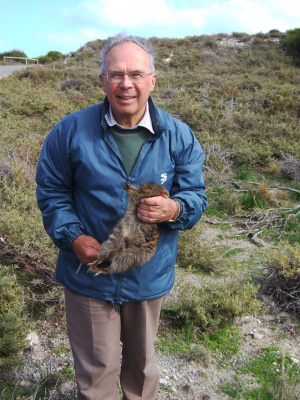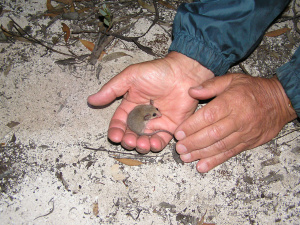Dr. Bill Holsworth
Founder of the Holsworth Wildlife Research Endowment
 I had to twist Bill’s arm for him to accept to be our first featured member. I wanted our very first feature to highlight a truly extraordinary member, but you could not tell from Bill’s interview that he is – he spent a lot of time explaining to me that others were much more worthy than himself. So let me tell you that, via his Wildlife Research Endowment, Bill has funded so many research projects on Australian wildlife that his impact is unfathomable. Knowledge on Australian mammals would not have flourished to the extent that it has without Bill, such is the influence of the Wildlife Research Endowment on the research landscape. Over 10 years ago, I asked Bill how he had managed to find money for such an endeavour, considering he did not own diamond or uranium mines (as far as we know). I will never forget his two-fold response: “making money is not difficult; you simply need not to spend it”. He then proceeded to show me his belt, the same one he has had since he was a young man, only with a few extra holes. Alas, as I stare at the many belts in my closet, I know with certainty that there will never be a Topa Petit Wildlife Research Endowment. The second part of his response was just as full of wisdom as the first: “it is not finding money that is difficult, it is giving it away.” Bill has been very successful in finding many deserving applicants. Enjoy our first feature.
I had to twist Bill’s arm for him to accept to be our first featured member. I wanted our very first feature to highlight a truly extraordinary member, but you could not tell from Bill’s interview that he is – he spent a lot of time explaining to me that others were much more worthy than himself. So let me tell you that, via his Wildlife Research Endowment, Bill has funded so many research projects on Australian wildlife that his impact is unfathomable. Knowledge on Australian mammals would not have flourished to the extent that it has without Bill, such is the influence of the Wildlife Research Endowment on the research landscape. Over 10 years ago, I asked Bill how he had managed to find money for such an endeavour, considering he did not own diamond or uranium mines (as far as we know). I will never forget his two-fold response: “making money is not difficult; you simply need not to spend it”. He then proceeded to show me his belt, the same one he has had since he was a young man, only with a few extra holes. Alas, as I stare at the many belts in my closet, I know with certainty that there will never be a Topa Petit Wildlife Research Endowment. The second part of his response was just as full of wisdom as the first: “it is not finding money that is difficult, it is giving it away.” Bill has been very successful in finding many deserving applicants. Enjoy our first feature.
Topa Petit, Membership Officer
Please give us a brief history of your background:
 I was born and raised on a farm in central Alberta, Canada, and like other farm boys I went fishing, hunting, trapping, and camping. From our house we could see the Rocky Mountains along the western horizon and 150 km of forested foothills.
I was born and raised on a farm in central Alberta, Canada, and like other farm boys I went fishing, hunting, trapping, and camping. From our house we could see the Rocky Mountains along the western horizon and 150 km of forested foothills.
My mother, a primary school teacher, was able to encourage my interest in natural history and get Junior Audubon Club information through the school. I have 3 sisters, one was a year older than me, and when she was 8 and I was 7 we created a “ Nature Club” and for several years we collected bird’s eggs and nests, butterflies, moths, skulls of mammals, yellow-jacket wasp nests (abandoned ones, not occupied), etc. We had a copy of “Birds of Canada” and recorded the arrival of spring migrants and kept nest records of robins, wrens, magpies, etc.
During the autumn hunting season my father and uncles hunted for deer, moose and elk in the forests near the mountains west of our farm. I listened to their discussions of how winter snow restricted the animals’ movements and access to food, and how their numbers were declining as more land was being cleared, grazed and cultivated. I wanted to learn more about these large herbivores but no one suggested that I could make a career of it.
What type of interesting research/projects have you conducted during your career and what is your “specialty” research/project?
My scholastic ability and the discovery of large oil fields in Alberta produced an incentive to go to the University of Alberta where I studied Civil Engineering for 2 years, but then I learned that there was a Zoology Department at the University and people studied birds and rabbits and other natural history topics. I was encouraged by the Professor to go to the University of British Columbia which had a much better natural history research program. I completed my B.Sc. (Hons) and M. Sc. with studies on deer, moose, elk, bison and bighorn sheep. In the 4-month summer breaks I worked for the Canadian Wildlife Service on the management of the large herbivores in the National Parks. In 1961 I arrived in Perth to begin research on the population dynamics of the quokka as my Ph. D. research project.
In 1964, with my wife Carol, I returned to Canada to the position of Assistant Professor at the University of Western Ontario. My research and my graduate students mostly studied deer and bison but I had a Ph. D. student study of effects mercury on wildlife. As a result of his work the government was forced to close for about 10 years the commercial and sport fishing in the Great Lakes of Canada.
While at the University of Western Ontario I took leave for over 3 years to work in Africa for the United Nations agency Food and Agricultural Organization (FAO), and UNESCO. I was in the Sudan for 4 months, Nigeria for a year and Kenya for 2 years. We left Africa in 1976 and came to Bendigo with our 4 children.
What are some of your achievements?
At the Bendigo College of Advanced Education, I was occupied with teaching until I ‘retired’ in 1986. During those years I was the Assistant Editor of the Journal of Wildlife Management for one year (1977) and served for 4 years on the Government of Victoria’s Land Conservation Council that determined the terms and use of the public land in Victoria. The Council recommended which areas should be set aside as new National and State Parks, Forest Reserves, Streamside Reserves, Uncommitted, etc. Other activities have related to local environmental concerns including fire management.
From 2007 to 2010 I was editor of Australian Mammalogy. I organised the change from the journal being published by the Australian Mammal Society to its current publisher, CSIRO Publishing.
What are some accolades that have pleased you particularly?
Knowing about the achievements of some of the 570 students that I have helped during the past 25 years.
What project(s) are you currently working on?
Expand the coverage of the Holsworth Wildlife Research Endowment to cover all the Universities in Australia (i.e. by expanding to NSW, QLD and ACT). This will occur in April 2014.
Do you have an interesting “mammal anecdote” you would be willing to share?
A few years ago Carol and I were walking along a bush path in the Toolangi Forest near the Murrindindi Cascades Picnic Area, north-east of Melbourne. I heard a branch break high in a Mountain Ash tree, looked up and saw a greater glider in the open on a dead branch. It paused there for a few seconds and then glided down to another branch where it paused again. Then the most interesting thing happened. It glided down to a small tree about 2 metres from me. It hung on to the small branches for a few seconds and then dropped to the thick ground storey and out of sight. Just then a group of orienteers passed us on their way to the picnic area. When they were out of sight I opened the ground cover, reached down and picked up the, now dead, greater glider. It had a large tear in the skin at the shoulder infested with fly larvae. I carried it back to the car, about 400 m., to the crowded picnic area. Not one of the orienteers looked at me or the possum I was carrying by its tail. The possum is now in the teaching collection of the Bendigo Field Naturalists Club as a museum study skin.
Do you have a piece of advice for people interested in Australasian mammalogy?
To preserve the habitat of the wildlife, we should spend more time exposing our knowledge to the general public. Presenting papers at conferences is not enough. Writing and speaking to the public, especially to the children, is most important.
Post a comment
You must log in or register to post comments.
If you are visiting this form to renew your membership enter your email address and password below.
Click on the forgotten password option if you are not sure of your password.

